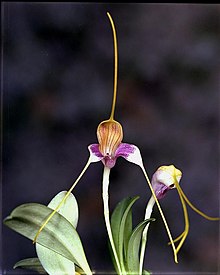Masdevallia
| Masdevallia | |
|---|---|
 |
|
| Masdevallia caudata | |
| Scientific classification | |
| Kingdom: | Plantae |
| (unranked): | Angiosperms |
| (unranked): | Monocots |
| Order: | Asparagales |
| Family: | Orchidaceae |
| Subfamily: | Epidendroideae |
| Tribe: | Epidendreae |
| Subtribe: | Pleurothallidinae |
| Genus: |
Masdevallia Ruiz & Pav. |
| Subgenera | |
|
About one dozen, see text |
|
| Diversity | |
| About 500 species | |
| Synonyms | |
|
|
About one dozen, see text
Masdevallia, abbreviated Masd in horticultural trade, is a large genus of flowering plants of the Pleurothallidinae, a subtribe of the orchid family (Orchidaceae). There are over 500 species, grouped into several subgenera. The genus is named for Jose Masdeval, a physician and botanist in the court of Charles III of Spain.
These plants are found from Mexico to southern Brazil, but mostly in the higher regions (2,500-4,000 m ASL) of the Andes of Ecuador and Colombia, Peru and Bolivia. They may be epiphytes, terrestrials or growing as lithophytes on damp rocks.
The plants are characterized by an abbreviated to elongate and creeping rhizome that gives rise to stems that lack pseudobulbs. The stem bears a single, fleshy, erect to pendent, ovate to lanceolate leaf. The flowers are triangular and occur singly or in racemose inflorescences. They are characterized by a showy calyx and reduced corolla. The sepals are fused at the base and frequently caudate. The petals flank the semiterete column and the tongue-shaped lip is flexibly hinged to a free column foot.
...
Wikipedia
